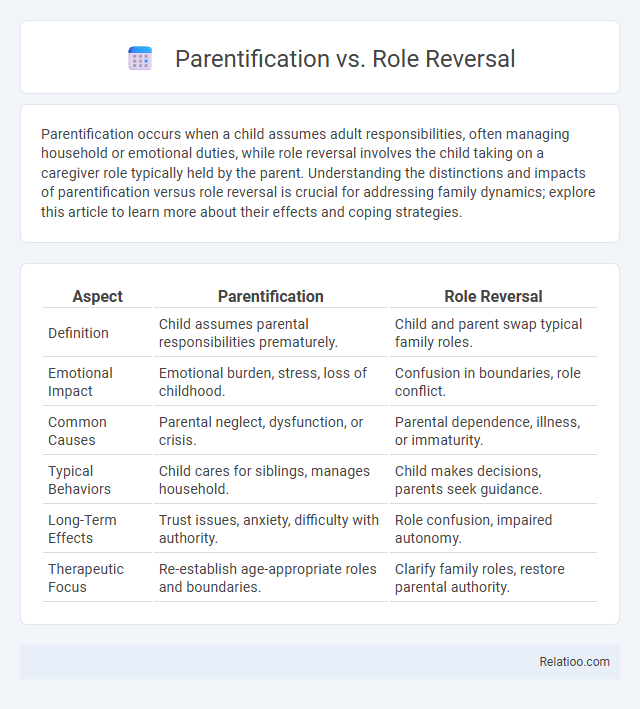Parentification occurs when a child assumes adult responsibilities, often managing household or emotional duties, while role reversal involves the child taking on a caregiver role typically held by the parent. Understanding the distinctions and impacts of parentification versus role reversal is crucial for addressing family dynamics; explore this article to learn more about their effects and coping strategies.
Table of Comparison
| Aspect | Parentification | Role Reversal |
|---|---|---|
| Definition | Child assumes parental responsibilities prematurely. | Child and parent swap typical family roles. |
| Emotional Impact | Emotional burden, stress, loss of childhood. | Confusion in boundaries, role conflict. |
| Common Causes | Parental neglect, dysfunction, or crisis. | Parental dependence, illness, or immaturity. |
| Typical Behaviors | Child cares for siblings, manages household. | Child makes decisions, parents seek guidance. |
| Long-Term Effects | Trust issues, anxiety, difficulty with authority. | Role confusion, impaired autonomy. |
| Therapeutic Focus | Re-establish age-appropriate roles and boundaries. | Clarify family roles, restore parental authority. |
Understanding Parentification: Definition and Dynamics
Parentification involves a child assuming adult responsibilities and emotional support roles typically held by parents, often leading to emotional and psychological strain. Unlike role reversal, where family members interchange roles temporarily or situationally, parentification implies a persistent expectation for the child to act as a caregiver or confidant to the parent. Understanding these dynamics is crucial in identifying the long-term impacts on a child's development, including issues with boundary setting, self-identity, and emotional regulation.
Exploring Role Reversal in Family Systems
Role reversal in family systems occurs when children assume responsibilities typically held by parents, often due to emotional or practical needs unmet by adults, leading to blurred boundaries and increased stress for the child. Parentification involves this role reversal but specifically highlights the child's caregiving role, such as providing emotional support or managing household tasks, which can impact their psychological development and future relationships. Understanding these distinctions helps identify dysfunctional family dynamics and guides therapeutic interventions to restore healthy roles and promote emotional well-being.
Key Differences Between Parentification and Role Reversal
Parentification involves a child assuming adult responsibilities and emotional support typically expected from parents, whereas role reversal specifically refers to a situation where the child takes on the parent's role entirely, often managing household decisions and discipline. Key differences include the scope and permanence of these roles; parentification may be temporary and emotionally focused, while role reversal usually entails a long-term, functional replacement of parental duties. Parentification often causes emotional burden and developmental challenges, while role reversal can lead to confusion about family boundaries and authority.
Psychological Impact on Children: Parentification vs Role Reversal
Parentification involves a child taking on adult responsibilities, often leading to emotional burden and impaired development of their own identity. Role reversal occurs when the child assumes the parent's role, which can cause confusion in boundaries and increased stress, impacting emotional stability and social relationships. Your understanding of these dynamics is crucial to recognize the psychological consequences such as anxiety, depression, and difficulties in forming healthy attachments.
Signs and Symptoms of Parentification in Childhood
Signs and symptoms of parentification in childhood include excessive responsibility for family caregiving, emotional neglect of personal needs, and chronic anxiety or stress due to adult-like duties. Children may exhibit hyper-vigilance, difficulty trusting others, and impaired social development as a result of role reversal where they take on parental roles prematurely. Your awareness of these symptoms can help differentiate parentification from role reversal, where boundaries between child and parent responsibilities are blurred, leading to emotional burden and role confusion in the family dynamic.
Recognizing Role Reversal Behaviors in Families
Recognizing role reversal behaviors in families involves identifying situations where children assume parental responsibilities beyond their age, often caring for siblings or managing household duties typically handled by adults. Parentification manifests when a child consistently meets emotional or practical needs of the parent, whereas role reversal specifically highlights the inversion of typical parent-child roles, leading to blurred boundaries and emotional stress. Awareness of these patterns enables mental health professionals to address the impact on child development and family dynamics effectively.
Causes and Triggers for Role Shifts in Families
Parentification occurs when children assume adult responsibilities prematurely, often due to parental neglect, illness, or emotional unavailability, leading to blurred boundaries in family roles. Role reversal specifically involves children taking on parental duties, triggered by crises such as divorce, substance abuse, or death of a parent, disrupting traditional family structures. Both dynamics stem from dysfunction in caregiving, where unmet emotional or practical needs of parents compel children to shift into caretaking roles, impacting their development and family functioning.
Long-Term Effects on Adult Relationships and Well-being
Parentification involves a child taking on parental responsibilities, while role reversal is a broader dynamic where child and parent roles switch; both can cause emotional burdens affecting Your adult relationships and well-being. Long-term effects often include difficulties with trust, intimacy, and boundary-setting due to unresolved childhood responsibilities and blurred family roles. Addressing these impacts through therapy can improve emotional health and foster healthier adult connections.
Strategies for Healing and Recovery from Unhealthy Family Roles
Healing from parentification, role reversal, and unhealthy family dynamics involves setting clear personal boundaries and seeking therapy focused on family systems and trauma recovery. You can benefit from support groups or counseling that emphasizes rebuilding your self-identity and coping skills separate from the caretaking role. Developing self-compassion and practicing consistent self-care routines are key strategies to reclaim autonomy and restore emotional well-being.
Supporting Families: Prevention and Intervention Approaches
Parentification involves children taking on parental responsibilities, while role reversal happens when parents depend on their children emotionally or physically, blurring family boundaries. Supporting families in these scenarios requires prevention and intervention approaches like family therapy, psychoeducation, and building healthy communication patterns to restore balance and promote emotional well-being. Your ability to recognize these dynamics early can improve intervention outcomes and support healthier family development.

Infographic: Parentification vs Role Reversal
 relatioo.com
relatioo.com